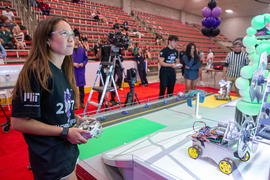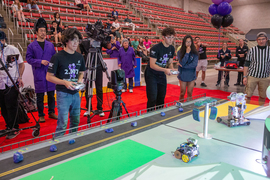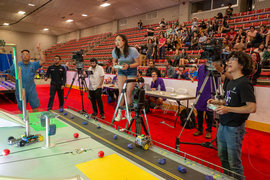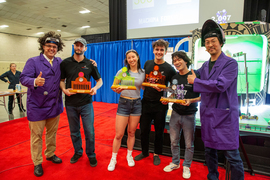On Tuesday evening, fans of all ages came to MIT’s Johnson Athletics Center to cheer on their favorite competitors as they took the arena, two at a time, in head-to-head contests that called for feats of strength, calibration, and torque.
Those competitors, by the way? Robots. Specifically, robots designed by undergraduates in MIT’s mechanical engineering course, 2.007 (Design and Manufacturing I).
Each year, students in the course, known simply as “two-double-oh-seven,” spend the spring semester learning the principles of mechanical design and applying those principles in the lab to build a robot from a kit of servos, circuit boards, and sheet metal. And here’s the fun part: They must design their robot to complete certain tasks on a life-sized game board with a theme that changes each year.
This year, 2.007 instructors modeled the game board after the movie “Black Panther: Wakanda Forever,” scenes of which were filmed on and around the MIT campus. Putting an MIT spin on the theme, the instructors billed the robot challenge as “Machina Forever” (“machina” is Latin for “machine”).
Tuesday’s event marked the culmination of 2.007, a final competition between the top-performing robots. All 85 students had competed in a preliminary contest the previous night. From there, the 32 students whose robots earned the highest points went on to the final round.
“You have students in this class who never picked up a drill before, and end up with really impressive robots in the end,” says 2.007 co-instructor and assistant professor of mechanical engineering Kaitlyn Becker. “They may have started out a little bit timid and nervous in the shop, [but now they can] take a nebulous idea, run with it, make something concrete that works well, and really show off their chops. It’s really fun to see.”
Across the board
This year’s 2.007 game board was inspired by “Wakanda Forever’s” main character, Shuri, the Black Panther’s sister and a scientist who attempts to manipulate DNA to recreate an essential herb. Instructors in MIT’s Pappalardo Lab built twin, side-by-side, life-sized game boards modeled after Shuri’s laboratory.
The centerpiece of each game board featured a rotating DNA helix made of white balls, with specific locations where a robot could place red balls to complete the genetic sequence — a tricky, “high risk, high reward” task that could earn a robot major points if completed. To each side of the helix, robots could also drive up a ramp to spin one or two wheels that resembled lab centrifuges, which in turn released balls into a receptacle, earning points with each ball released. Each wheel required a different amount of torque, which a robot must match to successfully spin. A robot could also spin a third, higher hexagon for additional points.
Robots could also drive up to a replica of the Massachusetts Avenue bridge, where a key scene of the movie was filmed. There, the robots could push purple rocks (resembling the fictional ore Vibranium) into a makeshift Charles River. At the center of the game board, robots could lift a bracelet off a stand for more points. And finally, robots could grab and pull on a ring, which in turn would pull a panther-like mask of the MIT beaver to one side of the game board — a move that could multiply a robot’s overall score.
Over the course of the evening, 32 students competed, two at a time, in two-minute matches that often pit robots of different designs and strategies against each other. Some students went for short, compact designs targeted to spin the centrifuges for fast points; others built telescoping designs to lift balls up and carefully place them into the rotating helix — a move that drew gasps and roars from the stands. Other students chose to incorporate winching systems to grab and pull on a ring for multiplying points, while others went with two-robot designs, each built to tackle a different task.
“The designs are really across the board,” remarked Pappalardo lab instructor Rob Podoloff, who like many of his co-instructors was dressed in a purple lab coat in homage to the fictional Shuri. “You see how they sort of cross-pollinate with each other, but it’s amazing to see the diversity of machines. It’s fantastic. Every year we’re surprised at what the students come up with.”
At the end of the night, the winning robot, designed by sophomore Ethan Chang, racked up an impressive 306 points by employing two machines — one to spin both centrifuges and the hexagon while the other pulled on the ring to shift the score-multiplying beaver mask. In preparing for the final match, Chang meticulously went through his own “preflight checklist.”
“That’s ‘Machina Forever,’ literally checking off boxes,” said co-instructor and Associate Professor Amos Winter, who gave a lively play-by-play of each match throughout the night. “This is really good diligence, and probably one of the keys to his success.”
From scratch
“For kids who think this is rocket science, it’s hard, but possible if you actually dive into it,” says sophomore Wilhem Hector, who named his robot Yibambe 394, the first part of which means “to hold strong and fast,” in the South African language Xhosa, which is spoken by the fictional Wakandans.
Hector, like many students, had not worked in the lab prior to 2.007.
“I was extremely scared going into this class, just from my lack of experience,” says Hector. “But I knew MIT was the best place on Earth to learn things, and 2.007 is the kind of class where you get what you make of it. And once you get the gist of learning, and realize there’s more to learn, you’re just excited to learn more. Then it became a habit for me to go into the lab.”
For the instructors, the enthusiasm of the students for hands-on work was especially clear this year.
“This year’s students went through a critical time as seniors in high school, then freshman on campus during the pandemic, so there were a lot of novices, but they had extra enthusiasm,” says co-instructor and Professor Sangbae Kim. “They were hungry for hands-on projects, and that really shined this year. Their delta, and how much they learned, was probably one of the largest we’ve seen.”
Many students, like sophomore Anna Duncan, credit the Pappalardo staff, for not only for providing engineering feedback and fixes, but also keeping up a welcoming and fun lab space.
“I’ll remember all the different things I learned about motors and servos, absolutely,” says Duncan. “But I’ll also remember how friendly everyone in the lab was, and how much fun I had, being able to create something from scratch, and having a lot of personal responsibility in it.”
This year’s 2.007 competition was the second held in person since 2020. But for some, it was the first that approached feeling “normal,” as distancing and masking requirements were lifted.
“What was really lost during the pandemic was that class-to-class folklore,” says Dan Braunstein, director of the Pappalardo lab. “The older students always tell stories to the younger ones, and that input is taken and helps guide what the younger ones are going to do. And you take a year or two slice out of our program, and you don’t have the continuity of those stories. We’re now finally getting a bit of that vibe back.”


























